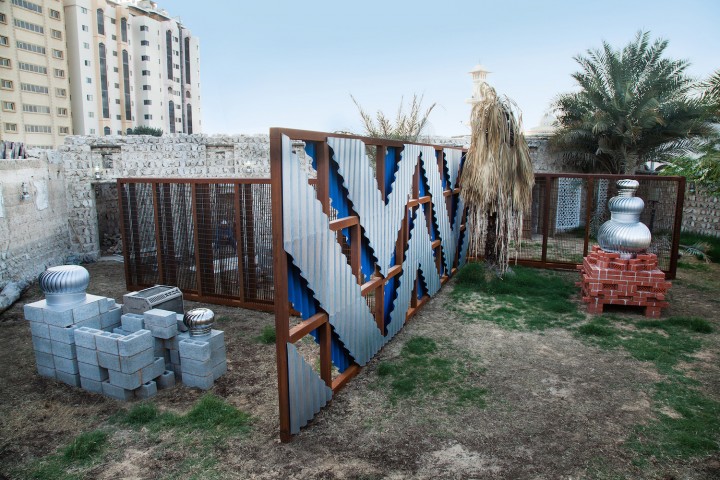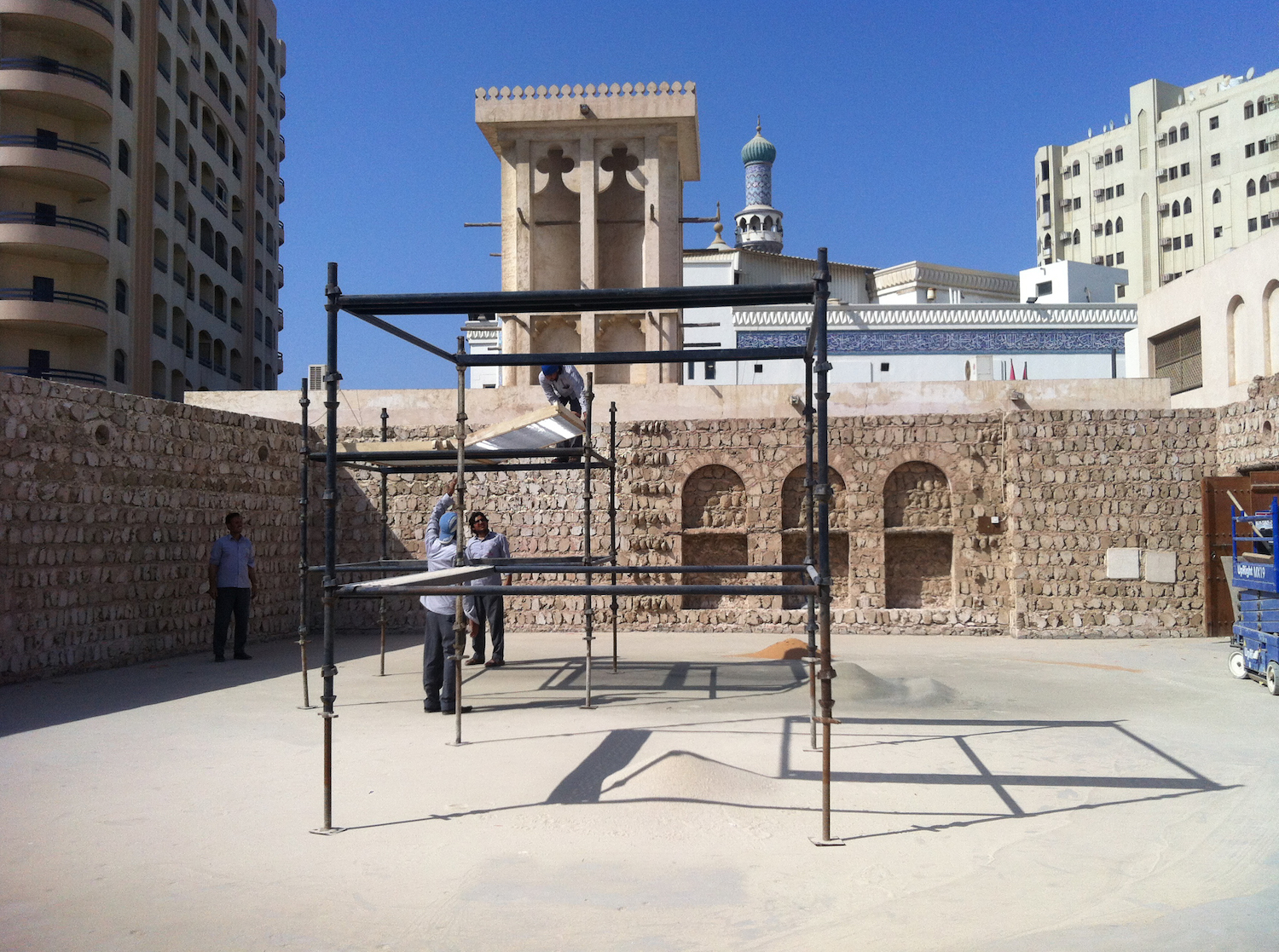“The Sharjah Biennial,” an editor of mine once opined, “has always been political, in a quiet way.” This year’s Sharjah Biennial 12, masterminded by Eungie Joo, formerly a curator at New York’s New Museum, has made quiet its buzzword. Rallied under the banner The past, the present, the possible, the featured works tug at an eternally slippery question: how can contemporary art still matter given today’s economic stranglehold and rampant political confinement? The answer, it seems, is somehow wound up in a quiet, thoughtful blend of contemplation and (re-)imagination. The city of Sharjah itself — in the throes of its own re-imagining, juggling its solemn love of tradition with its judicious taste for progress — is at the core of Joo’s admittedly utopic prospect.
Introspective and pensive, Sharjah Biennial 12 is a somewhat less gregarious affair than previous iterations, which have merrily embraced the largely South Asian community neighboring its principle exhibition areas. But what the biennial may have lost in community engagement, it has amply gained in the depth of its artists’ involvement with the urban fabric of Sharjah. Thirty-six artists from the succinct roster of fifty-five have made newly commissioned works, many of which were conceived and executed on site, after months of excursions across the city — soaking up its pace, substance, quirks and ambitions — starting from March 2014.
Sharjah alternatively inspires and bears the marks of invited artists’ interventions. A 14th-century model of a rosewater distillery in the Sharjah Museum of Islamic Civilization — allegedly resembling Duchamp’s iconic Bottlerack — inspired Rirkrit Tiravanija’s elaborate Untitled 2015 (Eau de Rose of Damascus)(2015). An exact replica of the ancient apparatus works as a functioning distillery, nestled in a courtyard rose garden that provides the raw material. Beirut-based artist Rheim Alkadhi sourced eyelashes from sea-faring laborers along the Sharjah Creek for her Communications from the Field of Contact (Each Hair is a Tongue) (2015), while Byron Kim’s City Night (2015) abstractions are contemplative records of Sharjah’s night sky — freeze-framing nocturnal solitude. Egyptian artist Hassan Khan made color-based “interventions” on the aptly named Flying Saucer building — a kitschy 1970s former fast-food chicken joint — toying at once with it obsolescence and its visibility.
The Flying Saucer is just one of four “transitional” urban spaces drafted into the Biennial’s off-site plotting. A dilapidated creekside warehouse housed Michael Joo’s Robert Smithson-inspired Locale Inscribed (Walking in the desert with Elsa, towards the sun, looking down) (2014–15), in which hewn crevices snake up to a reflective silver nitrate–coated wall in a spooky excavation-meets-self-examination installation. Nearby, Spanish artist Asunción Molinos Gordo transformed a soon-to-be-demolished storehouse into a “museum” crossing the dusty colonialist codes of outworn museography with forward-looking agro-technology-speak. WAM (World Agriculture Museum) (2010–15), resonating with the very title of the biennial, is a museum of the future mired in the past, in which present promises forebode fragile outcomes.
The most triumphal of these off-sites was also the farthest-flung. On the Gulf of Oman, in the east coast Sharjah exclave of Kalba, stood a derelict ice factory, the monumental site of the single work that brought the entire biennial’s meaning into sharper focus. Adrián Villar Rojas’s Planetarium (2015), as the title implies, is a vantage point: a site to observe what is real and alien, nature and spectacle. Cavity-riddled cement pillars are packed with detritus of all stripes — bird skeletons, gnarled sneakers, festering gourds, rotting spuds. In a surprising explosion of color, Rojas has painted the tops of the columns, making the raw concrete bottoms seem like plinths holding up cross-sectioned layers of startlingly aesthetic debris. The site is at once stark and sumptuous, stately and putrid. Whiffs of decomposition waft across the expansive space punctuated by varyingly shaped concrete blocks, one of which resembles a makeshift altar, while another’s top is engulfed by a yellow, Lynda Benglis-like paint blob. Outside, giant rows of peaty soil (utterly alien to this desert clime) hunch like sacred mounds on some Neolithic site. In one memorable masterstroke, Rojas lures us into a teeming, decaying world, which we ponder with near-existential wonderment.
Wonderment courses through the simple, graceful gestures that abound in the biennial’s more traditional sites: Pakistani artist Lala Rukh’s sublime meditations on the horizon line; Mohammed Kazem’s “scratchings” on plush, cottony paper of a souk stall’s door angling into the space; Unnikrishnan C’s intimate brick paintings; Rayyane Tabet’s graceful Steel Rings (2013-ongoing), tunneling across an entire wing of the Sharjah Art Museum — a poetic stand-in for the forgotten trans-Arab pipeline.
More overtly political works seem to bring us to the brink of some milestone, leaving us to ponder an aftermath: the final chapter of Basel Abbas and Ruanne Abou-Rahme’s Incidental Insurgents (2012–15), titled When the fall of the dictionary leaves all words lying in the streets (2015), explores the liminal space between the political present and its unseen potential direction; Eric Baudelaire examines the stateless state of Abkhazia in The Secession Sessions (2014–15); and Im Heung-soon’s haunting Reincarnation (2015) reveals a community of Korean women who lived in pre-1979 Tehran.
Sharjah Biennial 12 is an elegant affair — a “museum-grade” biennial, with not a hair out of place. More sedate than seditious, it is the fruit of Joo’s maturing conversations with artists she knows well, having shown several of them already in her 2012 New Museum Triennial, The Ungovernables. While some bemoan the lack of new artistic “blood” injected into this particular biennial vein, there is obvious merit to mining familiar practices more deeply. Perhaps because of this control and composure, Sharjah Biennial 12 has managed to round up works that provoke consideration… ever so quietly.


